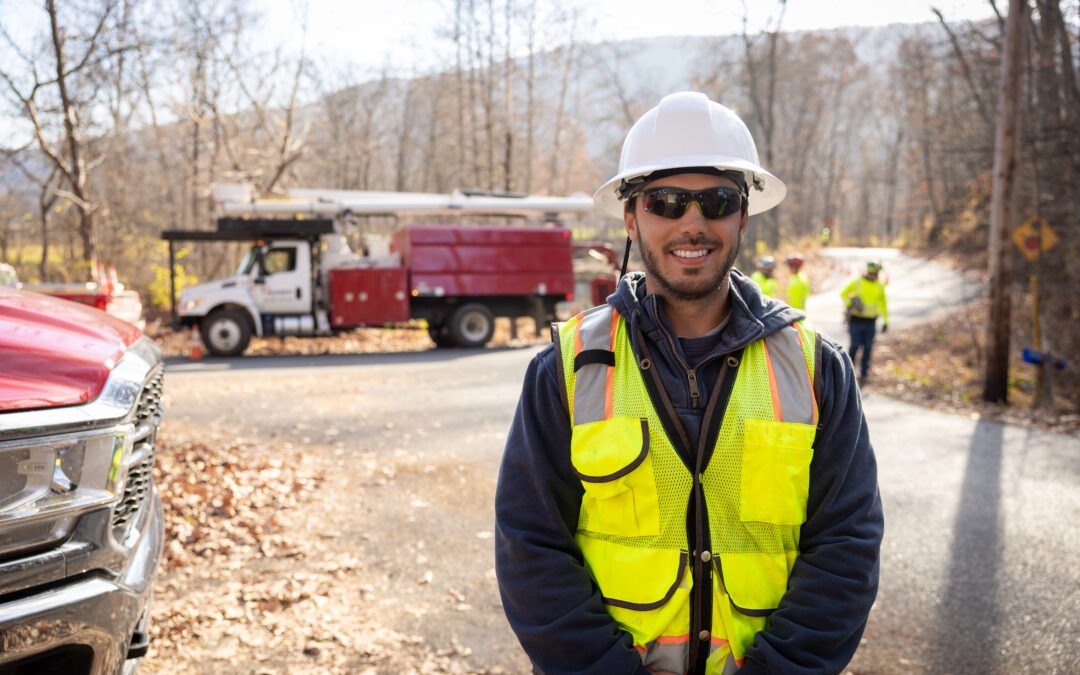
Feb 6, 2025 | Reliability
Nothing is more gratifying to Casey Rishel than knowing the work he does each day helps PPL Electric Utilities deliver safe, reliable power to nearly 1.5 million customers.
As a forester, Rishel plays a key role in balancing two important responsibilities: managing trees so they don’t cause power outages and protecting and preserving wooded areas.
He’s a member of a team of foresters that oversees year-round tree trimming and other vegetation work that helps keep power lines clear to prevent outages.
“During our storm response and routine maintenance, it’s very rewarding when you are able to explain to a customer the process that a tree crew is going to use to remove or trim trees,” said Rishel, who is based at PPL Electric’s Montoursville Service Center in Lycoming County. “Many times, it involves specialized equipment or unique methods of rigging.
“Making sure customers know what will be happening on their property or an adjacent property when tree crews do their work and making sure everyone in work areas stay safe are top priorities.”
Rishel, who was born and raised in Lycoming County and earned a forestry degree from Pennsylvania College of Technology in Williamsport, is a certified arborist and licensed applicator. He’s among the expert foresters on PPL Electric’s staff that work with line clearance-certified arborists to thoughtfully prune and remove trees along power lines and high-voltage power corridors.
Foresters work directly with line clearance-qualified tree contractors who do the work on a cyclical basis. Before any pruning or tree removal occurs, vegetation conditions are assessed based on each tree’s species, growth rates, distance from the lines and time since the last vegetation work was performed.
And when we do the work, our goal is to complete it in a professional manner, treat private property with care and remain sensitive to individual landowner concerns about vegetation management while doing the work that is needed to improve electric service reliability for all customers.
In 2024, our crews trimmed trees along more than 5,000-plus miles of roadways and rights of way and removed more than 13,000 trees identified as having the potential to cause outages for our customers.
For more information on our foresters, the line clearing work we do and planting and safety tips for customers, visit pplelectric.com/LineClearing.

Sep 2, 2024 | Safety and Security, Storms and Outages
As we enter September, a month dedicated to preparedness, it’s a good time to review how we can best protect ourselves, our loved ones and our community from unexpected emergencies. National Preparedness Month is a reminder that disasters can strike at any time, and being prepared can make all the difference.
While we do many things throughout the year to remain prepared for storms and emergencies, we encourage you to do the same. Here’s how you can get ready, stay connected, and stay safe—before, during, and after a storm:
Get prepared:
- Create an emergency plan and discuss what your family would do in different scenarios, such as a power outage, sever weather or other disasters. Identify a meeting place, ensure everyone knows how to contact each other, and practice your plan regularly.
- Prepare an emergency kit with food, water, medication, flashlights and pet supplies.
- Charge your phones and devices.
- Make alternate plans if you have a medical condition which requires electricity.
- Purchase power strips with lightning arresters or surge protectors for your appliances and electronics.
- Consider installing lightning rods on your property.
Stay connected:
- Sign up for local emergency alerts and stay tuned to the weather forecast.
- Report power outages online at pplelectric.com or text “Outage” to TXTPPL (898775).
- Sign up for alerts to stay connected and receive outage updates at pplelectric.com/alerts.
- Check the status of an outage and estimated restoration times online at pplelectric.com/outage.
- Follow us on social media, where we will post the latest storm and restoration updates.
Stay safe during and after storms:
- Stay away from utility poles and metal conductors.
- If you encounter a downed wire at any time, assume it’s energized and stay away. If you see one, report it immediately to PPL Electric.
- Electric and plumbing equipment may carry lightning current. Avoid using any appliances or electronics plugged into an electrical outlet.
- If using a portable generator during a power outage, never operate the generator in an enclosed area, like a garage, where deadly carbon monoxide fumes could accumulate.
- Remember that candles can start fires. Always use flashlights instead.
- If you lose power, turn off any appliances that were on when the power went off.
- For your safety and ours, please keep a safe distance from our crews.


How we prepare
At PPL Electric Utilities, we do many things throughout the year to remain prepared for storms and emergencies. That includes the work we do to strengthen and modernize our energy grid to prevent power outages from happening when outage-causing storms strike.
We also monitor the health of the electric system through helicopter and drone inspections, and we use sensors and infrared technology to make upgrades and repairs.
And we’ve developed industry-leading smart grid technology that reduces the number of customers affected by outages and automatically reroutes power around trouble spots. Since 2015, approximately 2 million outages have been avoided due to smart grid technology. And since trees are the leading cause of outages during storms, trees and vegetation are trimmed along thousands of miles of power lines each year.
Other reliability improvements include:
- Upgrading power lines and poles with stronger, more storm-resistant materials across our distribution and transmission systems.
- Adding more automated sensors for improved fault isolation and restoration.
- Deploying predictive sensors to identify issues before outages occur.
- Installing avian guards and lightning protection along transmission lines.
Storm preparation and response
We also monitor weather forecasts daily and look days ahead to begin preparing and mobilizing resources when severe weather is expected. As storms approach, we activate our storm teams with additional personnel in the field, and at control centers and on our customer service staff across the 29-county service territory. We may implement 16-hour shifts for around-the-clock coverage. And we dispatch crews and resources to respond as safely and quickly as possible to any outages that may occur.
When storms cause outages, an established restoration process is followed to get all customers back in service as safely and quickly as possible. While every customer is a priority, critical systems like hospitals come first. After the most critical systems are restored, workers move on to repairing lines that will bring back electricity for the largest number of customers and then smaller neighborhoods, individual homes and businesses.
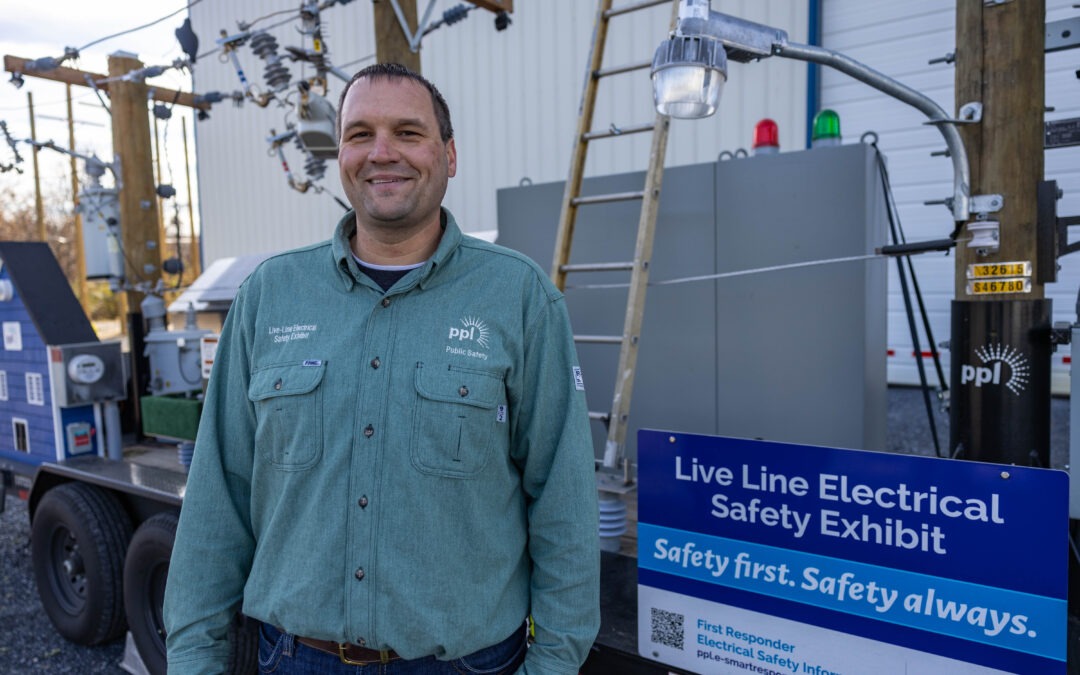
Aug 12, 2024 | Uncategorized
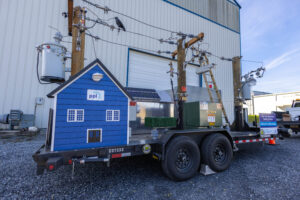 Nothing is more gratifying to Bill Farber than knowing his hard work at PPL Electric Utilities has helped tens of thousands of Pennsylvanians live and work more safely.
Nothing is more gratifying to Bill Farber than knowing his hard work at PPL Electric Utilities has helped tens of thousands of Pennsylvanians live and work more safely.
It may even have saved some lives.
Farber, an electrical engineer in his 16th year at PPL Electric, is the brains behind the company’s popular Live Line Electrical Safety Exhibit, a traveling display used to teach first responders, contractors, utility companies and others across 29 Pennsylvania counties how to stay safe around electricity.
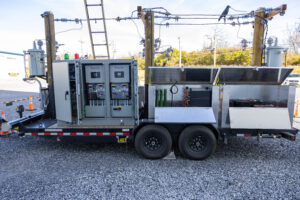 Farber, who designed and built the company’s original exhibit in 2015, put his skills to the test in 2023 when he built an updated version powered completely by solar energy and batteries. He spent approximately 300 hours of his own time over 10 months – often after workdays and on weekends – to design, engineer and build it. And tens of thousands of people have seen his handiwork in action.
Farber, who designed and built the company’s original exhibit in 2015, put his skills to the test in 2023 when he built an updated version powered completely by solar energy and batteries. He spent approximately 300 hours of his own time over 10 months – often after workdays and on weekends – to design, engineer and build it. And tens of thousands of people have seen his handiwork in action.
For more about the exhibit, check out this video.
“It’s definitely rewarding,” Farber said. “If we’re able to save one life doing this, it makes it completely worth it.”
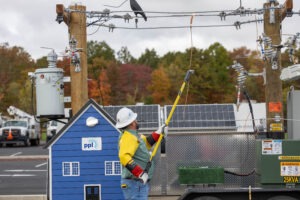 The exhibit is a scaled-down 7200-volt electrical distribution system that features live electrical wires, utility poles, transformers and fuses. Using ladders, gloves, shovels and other tools in a controlled environment, trained PPL staff wearing protective equipment will show the spark, flames, smoke and crackle that occur when those items come in contact with live electrical lines.
The exhibit is a scaled-down 7200-volt electrical distribution system that features live electrical wires, utility poles, transformers and fuses. Using ladders, gloves, shovels and other tools in a controlled environment, trained PPL staff wearing protective equipment will show the spark, flames, smoke and crackle that occur when those items come in contact with live electrical lines.
The new exhibit eliminated the need to power components with a generator and allows the company’s Public Safety group to incorporate lessons about battery and solar power, which demonstrate how green energy sources, including solar panels and battery storage, produce power onto the electric grid. It’s an important addition to electrical safety demonstrations because it underscores the potential hazards associated with improper electrical back-feed onto the grid.
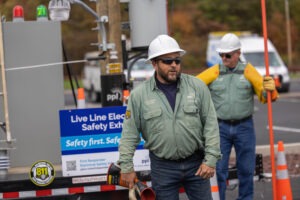 “We use it to encourage customers to consider solar power and battery storage as an option to reduce their energy bills, and at the same time, we need our first responders and contractors to understand those components can back feed our system just like a generator can today,” said Farber.
“We use it to encourage customers to consider solar power and battery storage as an option to reduce their energy bills, and at the same time, we need our first responders and contractors to understand those components can back feed our system just like a generator can today,” said Farber.
Since 2015, more than 72,000 people have seen the exhibit in action at fire halls, and special events like the Bloomsburg Fair. The 2024 tour began in March and will continue through November.
Doug Haupt, manager of PPL Electric’s Public Safety department, which provides the safety demonstrations, said the exhibit is a critical tool in teaching the public how to stay safe around electricity.
“It only takes a split second for someone to do something near electricity that could have serious consequences,” he said. “We take safety very seriously. Not only for our employees, but for our customers, first responders and contractors as well.”
Reflecting on the importance of these safety demonstrations, Haupt added, “One of the things I hear most is, you’ll never know how many lives you have saved by doing these presentations for our first responders and contractors. We’ll never know.”
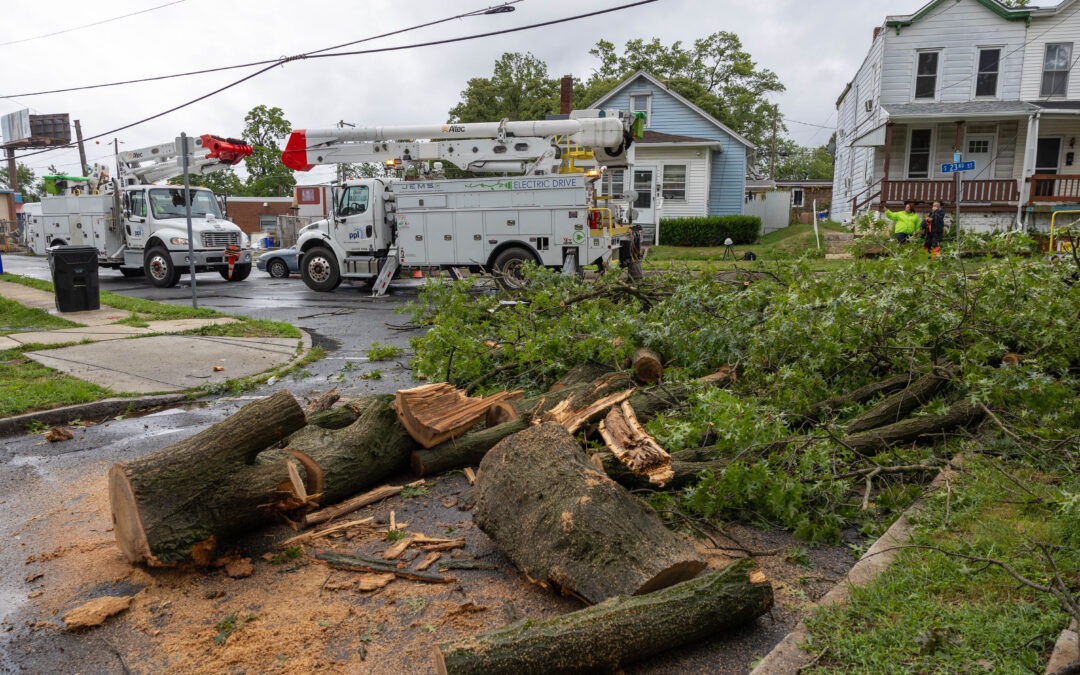
Aug 9, 2024 | Storms and Outages
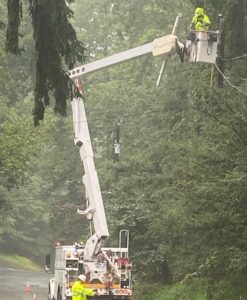 (Updated at 8:30 p.m. on Saturday, August 10)
(Updated at 8:30 p.m. on Saturday, August 10)
PPL Electric Utilities lineworkers and support staff continue working around the clock to restore power for customers who experienced outages due to the remnants of Tropical Storm Debby that swept through the area on Friday (8/9).
The utility brought in nearly 1,000 workers from other companies to supplement its crews to safely make repairs at more than 800 damage locations across PPL Electric’s 29-county service territory.
Following are the latest updates:
- As of 8:30 p.m. Saturday (8/10), crews had restored power to approximately 75,000 customers since the storm began. Approximately 2,300 of our 1.5 million customers were without power.
- All customers who experienced outages before 6 p.m. Friday (8/9) are expected to have their power restored by 11 p.m. Saturday (8/10).
- Any customers who lose power after 6 p.m. Friday (8/9) will have estimated restoration times of 3 p.m. Sunday (8/11).
Safety continues to be our priority. Remember, to keep these tips in mind:
- If you encounter a downed wire, assume it’s energized and stay away. Report downed wires to PPL Electric or local emergency response agencies.
- If using a portable generator during a power outage, never operate it in an enclosed area, like a garage, where deadly carbon-monoxide fumes could accumulate.
- Remember that candles can start fires. Always use flashlights instead.
- If you lost power, turn off appliances that were on when the power went off.
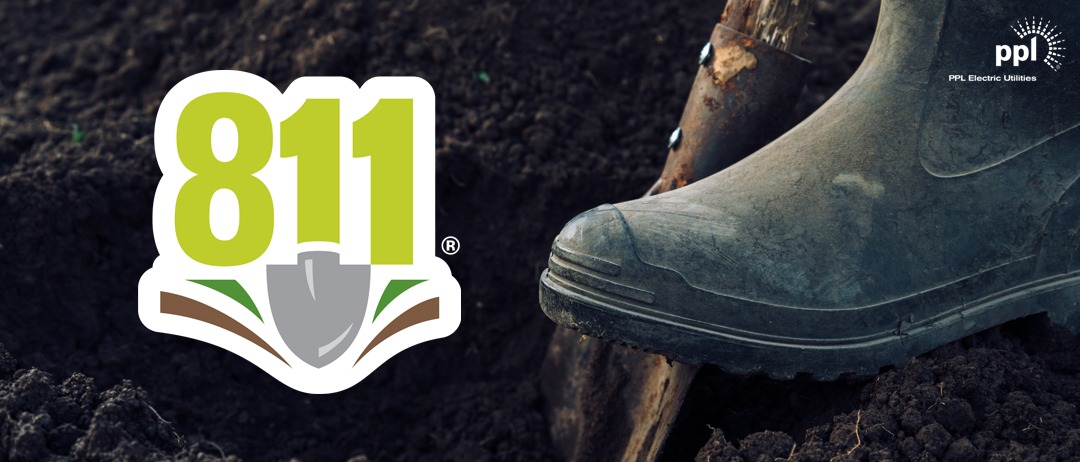
Aug 6, 2024 | Safety and Security
Nothing is more important than ensuring everyone stays safe near our power lines and electrical equipment, including underground power lines.
We always call 811 at least three business days before any project that involves digging for the safety of our employees, contractors and customers.
On National 811 day, we urge everyone to make the 811 call a normal part of their routine whenever they take on digging projects at home, whether it be adding a fence, deck, tree or mailbox, or any other work that involves digging.
Calling 811 – it’s always free for homeowners – helps prevent injuries, damage to underground power lines and power outages.
Pennsylvania law also requires an 811 call at least three business days before digging. The call helps ensure that underground utility owners can arrange visits to the site to locate and mark all areas where underground utilities — electrical gas, water or sewer lines – exist.
When making an 811 call, make sure to have the following information:
- The county and municipality in which the digging is located.
- The street name and address.
- The nearest intersection/cross street to the address.
- Details of the dig site, including the area of the property where excavation will occur and what kind of work is being done, and what equipment will be used.
Visit paonecall.org for more information about 811 and safe digging practices.












